The Revista Guillermo de Ockham provides an immediate and open access to its content, based on the principle of offering the public a free access to investigations to provide a global interchange of knowledge.
Unless otherwise established, the contents of this journal has a license with Creative Commons Attribution-NonCommercial-NoDerivatives 4.0 International (CC BY-NC-ND 4.0) http://creativecommons.org/licenses/by-nc-nd/4.0/
- Attribution: You must give appropriate credit, provide a link to the license, and indicate if changes were made. You may do so in any reasonable manner, but not in any way that suggests the licensor endorses you or your use.
- NonCommercial: You may not use the material for commercial purposes.
- NoDerivatives: If you remix, transform, or build upon the material, you may not distribute the modified material.
- No additional restrictions: You may not apply legal terms or technological measures that legally restrict others from doing anything the license permits.
Abstract
Taking as a broad context the notion of “Latin American cultural space”, this reflection seeks to discover some basic conditions of possibility so that those who have the initiative to create contemporary educational-cultural objects may have some keys of meaning to guide their work, both for the conception, design, promotion and, above all, the effectiveness of their attempt. This objective leads to a hermeneutic revision, in a cultural key, of a selection of novels by the American writer Paul Auster. The hypothesis that guides the journey through the plots and characters of these works is to consider that their configuration and dynamism point to the postmodern, considered as distinctive of the contemporary cultural epoch. In this way, and after analyzing the author's works, where cultural features tending to the postmodern are collected, we reflect with some theoreticians on concepts that help to configure an intelligent synthesis of the previous. Thanks to this, it is conceived that in the face of the dislocation of the modern meta-narrative, postmodernity cultivates a renewed conception of emancipation that tends to manifest itself in artistic aesthetics with a post-autonomy logic. Thanks to these connotations of meaning, it is possible to suggest certain preconditions of action for the support of contemporary educational-cultural creation. This is significant for the intercultural movement because, in the search for a plural coexistence in a common world, it is favorable to count on orientations that help to better identify contemporary cultural subjects and thus offer them their proposal from a pertinent and accessible language to their sensibility.
Keywords:
References
Auster, P. (1989). El país de las últimas cosas. Edhasa.
Auster, P. (1990). La invención de la soledad. Edhasa.
Auster, P. (1996). La trilogía de Nueva York. Anagrama.
Bauman, Z. (2002). La ambivalencia de la modernidad y otras conversaciones. Paidós.
Bauman, Z. (2005). Vidas desperdiciadas: la modernidad y sus parias. Paidós.
Bolaño Quintero, J. (2021a). Los personajes postmodernos de Paul Auster: una dicotomía relativista/referencial. Cuadernos de Investigación Filológica, 49, 25-42. https://doi.org/10.18172/cif.4959
Bolaño Quintero, J. (2021b). Paul Auster’s transcendentalism: Shifting postmodern sensibil-ity in the new millennium. Journal of English Studies, 19, 3-21. https://doi.org/10.18172/jes.4750
Calinescu, M. (2003). Cinco caras de la modernidad: modernismo, vanguardia, decadencia, kitsch, posmodernismo. Alianza.
Chen, R., Liu, S., Lin, J., y Kan, M. K. (2022). Paul Auster and August Brill’s solitary rooms: The spatiality of solitude. Trans/Form/Ação, Marília, 45(4), 183-204. https://doi.org/10.1590/0101-3173.2022.v45n4.p183
Curieses, Ó. (2014). Diálogo con Paul Auster. Cuadernos Hispanoamericanos, (763), 78-82.
De Maeseneer, R., y Bolognese, C. (2017). “Tan oscuro como muy oscuro”: ¿dónde se ubica Ena Lucía Portela? Rilce: Revista De Filología Hispánica, 33(1), 87-107. https://doi.org/10.15581/008.33.1.87-107
Eco, H. (2021). De la estupidez a la locura: crónicas para el futuro que nos espera. Penguin Random House.
Frisby, D. (1992). Fragmentos de modernidad en la obra de Simmel, Kracauer y Benjamin. Visor Distribuciones.
García Canclini, N. (2010). La sociedad sin relato: antropología y estética de la inminencia. Katz.
Garretón, M. A. (2003). El espacio cultural latinoamericano: bases para una política cultural de integración. FCE.
Girard, R. (1985). Mentira romántica y verdad novelesca. Anagrama.
Habermas, J. (2008). El discurso filosófico de la modernidad. Katz.
Haj’jari, M. J., y Maleki, N. (2022). Auster’s Man in the dark: human existence and respon-sibility for creating possible worlds. Atlantis, 44(2), 126-149. https://doi.org/10.28914/Atlantis-2022-44.2.07
Jameson, F. (1991). El posmodernismo o la lógica cultural del capitalismo avanzado. Paidós.
Jameson, F. (1996). Teoría de la postmodernidad. Trotta.
Koselleck, R. (1993). Futuro pasado: para una semántica de los tiempos históricos. Paidós.
Laclau, E. (1998). Política y los límites de la modernidad. En R. N. Buenfil (Coord.), Debates políticos contemporáneos: en los márgenes de la modernidad (pp. 55-73). Plaza y Valdés.
Lanz, R. (1998). Esa incómoda modernidad: pensar desde América Latina. En R. Follari y R. Lanz (Comps.), Enfoques sobre postmodernidad en América Latina (pp. 75-118). Sentido.
Lanz, R. (2000). El discurso postmoderno: crítica de la razón escéptica. Universidad Central de Venezuela.
Lanz, R. (2005). Las palabras no son neutras: glosario semiótico sobre la postmodernidad. Monte Ávila Editores Latinoamericana.
Lanz, R. (2006). El discurso político de la postmodernidad. Ediciones FACES/UCV.
Lyotard, J. F. (1994). La postmodernidad, explicada a los niños. Gedisa.
Monod, J. (1985). El azar y la necesidad: ensayo sobre la filosofía natural de la biología moderna. Tusquets.
Mora, J. P. (2005). Globalización y “glocalización” frente al debate postmoderno. Research Gate. https://www.researchgate.net/publication/242669490
Mora, J. P. (2023). La escuela del día de después: la escuela, el maestro y el saber pedagógico en/desde la postmodernidad. Serbiula (Sistema Librum 2.0).
Rorty, R. (1991). Contingencia, ironía y solidaridad. Paidós.
Sivira, W. (2010). Pedagogía y educación postmoderna en el pensamiento de José Pascual Mora. Revista Educare, 14(3), 135-147. https://revistas.investigacion-upelipb.com/index.php/educare/article/view/235
































